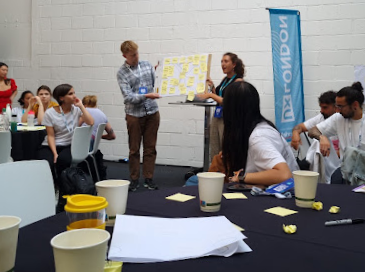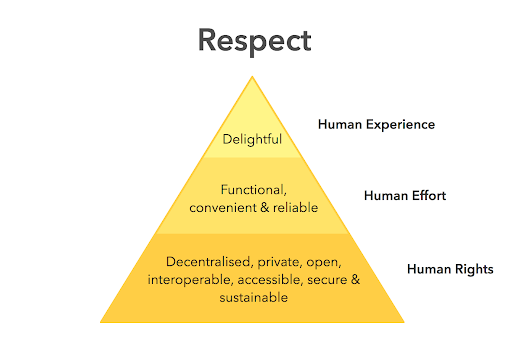When you design a product or service, do you ever wonder if what you are putting out into the world is the right thing to do? Or are you so focused on making the product a success and getting it into the hands of millions, you sometimes lose sight of the future ramifications this could have on people’s lives?
Technology is advancing at such a rapid rate that it’s difficult for those who innovate to anticipate all the consequences it may have. Inevitably, regulation is also slow in keeping up with this pace - which can lead to it being too late to prevent the damage that has already been done. This means it’s down to us who work in this industry to take responsibility for what we design and prevent or minimise future risks in the absence of regulations.
I recently attended UX London 2022 - a conference that included a provocative keynote speech by Kat Zhou about this very subject as well as a workshop to share some practical tools to help solve these challenges.

Kat is a world renowned designer who has worked at big tech corporations like Spotify and IBM. She is also the founder of Design Ethically, which provides a framework to help leading industry experts to use ethical practices when creating products for the companies they work for.
Her view is: “Nobody is neutral and doing nothing is not neutral.”
At Unboxed one of our main motivations for working on products and services is to do good. Continuous improvement is practically written in our DNA as it’s one of our core values as is:
- paying care and attention in our work
- being open and transparent about what we do
- learning by doing in how we design and build products
- ensuring we build healthy relationships with everyone we work with including our end users
It therefore feels pertinent to share some valuable insights from Kat’s talk which align with these values. Here are some of my key takeaways and thoughts.
Product design ethics defined
The Oxford Dictionary describes ethics as ‘moral principles that govern a person's behaviour or the conduct of an activity’. This takes me back to when I studied applied ethics at university but we won’t get into that now as that’s a discussion for another place and time!
To put it more simply, Kat’s explanation of ethics is a set of standards that help us determine what we should or shouldn’t do. But also that we shouldn’t confuse what is ethical and what is legal as being the same thing. For example at one point slavery was legal but this didn’t mean it was ever ethical.
When thinking about product design this can broken down into 2 areas that are:
- duty-based - where we should be thinking about the ‘intent’ of whether this is a worthy problem to solve?
- results based - where we should be thinking about the ‘consequences’ that our solution is likely to have?
Both areas should provide the end user with:
- autonomy - this means allowing users to have control, such as the ability to opt-out and opt-in within their settings
- transparency - where users know up front what they are signing up to
- safety - this includes privacy, emotional or physical wellbeing and inclusion
Beware of deceptive design
Deceptive design includes using ‘dark patterns’ where user interfaces (UI) mislead users and make them perform tasks that they wouldn’t necessarily wish to do. There are plenty of examples on the Hall of Shame page of the Deceptive Design website.
Other examples of deceiving users/ customers are tactics like ‘greenwashing’ where companies trick people into thinking they are producing environmentally friendly products to get people to buy or use them. If you’re interested in this topic it’s worth having a read of Leyla Acaroglu’s article ‘What is Greenwashing? How to Spot It and Stop it’.
We see these practices all the time but is it something we should be worried about? The answer is yes as both the Federal Trade Commission (FTC) and EU are starting to recognise that these methods are unfair practices as it’s the most vulnerable who become manipulated by these tactics.
But why wait for that to happen when we can start to address this now in our designs?
The ethical design challenge
Right now you’re probably thinking this all sounds good in theory, how do we actually go about making this happen in our day to day design work? Depending on your organisation or the type of clients you work with - there is the additional question of how do we get the ‘buy in’ for being more ethical in our approach?
Kat’s suggestion is to incorporate this into our current design process. For example the design process could be described as:

You can still use this process by adding 3 more steps to consider the ethics of intent and results in your design:

In the intent phase of the process this is where you would evaluate after you’ve defined your problem statement as to whether this can be ethically addressed.
For the results phase you need to forecast your outcomes after ideating. You should work with your team to scope out any ethical ‘weak spots’ or if there is a possibility that your product could be unethically exploited.
Once you’ve shipped your product you should also monitor it to see if there are any ethical problems that you can quickly address and solve with your team.
For more detail on tools on how you can make these assessments you can see this on the Design Ethically website.
Reframe your success measures to create delightful products
It’s now more widely accepted that the success of a product is not just about meeting KPIs or the ROI to drive people’s usage. It is also about the impact it has to solve problems for our users rather than add to their problems. Getting the numbers doesn’t always mean the best outcome.
A good way to think about it is the ethical hierarchy of needs by Ind.ie (a not-for-profit organisation that champions social justice in the digital sphere).

You start with thinking about human rights to ensure your product aligns with ethics. If your product's only purpose is to manipulate user data, use deceptive design and is purely out to make money regardless of the real social or human cost, then there is a good chance it’s unethical.
By considering the wider human impact we can create products that are not only profitable but also ethical.

